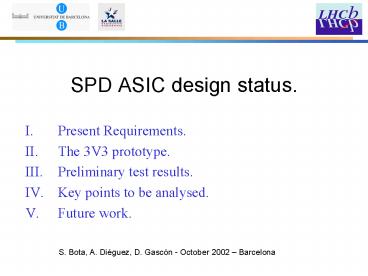SPD ASIC design status' - PowerPoint PPT Presentation
1 / 21
Title: SPD ASIC design status'
1
SPD ASIC design status.
- Present Requirements.
- The 3V3 prototype.
- Preliminary test results.
- Key points to be analysed.
- Future work.
S. Bota, A. Diéguez, D. Gascón - October 2002
Barcelona
2
I. Requirements (Energy measurement)
Energy deposition in a SPD cell (electrons and
photons).
- Energy deposition
- Random signal shape (20-30 phe/MIP)
- Shaping methods discarded
Single event MIP signal
Integrate
BW?100 MHz
3
I. Requirements (Timing)
Average MIP signal
- Only about 80 of signal in 25 ns
- No dead time on integration
?d ?12 ns
- Dual channel synchronous system
- Pile-up correction
Normalized integral of Cosmic ray signals in main
and secondary period
4
I. Requirements (Other)
- PMT gain limited by aging (DC current) ?
100fC/MIP in central cells (HV650V). - Resolution ? 0.05 MIP (ltlt resolution given by
photostatistics). - 5-10 MIP range to perform tail correction.
- Bandwidth gt 100MHz.
- Linearity error lt 5.
- Robust to temperature variations (band gap
reference). - Small cavity ? Power consumption lt 1W.
5
II. The 3V3 prototype
6
II. The 3V3 prototype (Input stage Preamplifier)
7
II. The 3V3 prototype (Input stage Integrator)
8
II. The 3V3 prototype (Input stage OpAmp)
9
II. The 3V3 prototype (Input stage Noise and
Offset)
Transfer function of a system that integrates for
?T?
- Noise
- Offset
10
II. The 3V3 prototype (Pile-up compensation
variable Gm)
11
II. The 3V3 prototype (Pile-up compensation
Track Hold)
12
II. The 3V3 prototype (Comparison input stage)
13
II. The 3V3 prototype (Comparison latched
comparator)
14
II. The 3V3 prototype (DAC)
7 bits floating DAC 1b for sign 6b for
modulus R-2R architecture
15
III. Preliminary Tests Results
- PRELIMINARY RESULTS (automatic set up in
progress...) - Supply voltage ?1.65 V
- Consumption 25 mA (19 mA channel 6 mA for
buffers). - Pile-up correction control VbiasH1.65V
VbiasL1.45V. - Threshold dispersion (OZE at integrator output)
65 mV r.m.s (for 10 samples) .
16
III. Preliminary Tests Results
- Noise lt 2 mV r.m.s
- Synchronous noise effects have been observed
- Systematic test under different conditions
(Threshold input, Pile-up control ....) when
automatic set-up will be ready.
17
III. Preliminary Tests Results
- Gain is about 3 times the gain of RUN2-3.
- Range for signal path is gt?1V (range for
compensation to be studied).
18
III. Preliminary Tests Results
- Linearity error of the generator has been
measured calibration is needed.
19
IV. Key points to be analysed
- Confirmation of offset measurements (20 chips
will be packaged). - Study of pick-up interference coming from
switching on offset and noise. - Sensitive points signal input, threshold input,
pile-up compensation control... - Dependence on board design...
- Study of pile-up compensation linearity
(Temperature!). - Matching of compensation factor (same control for
different channels).
20
IV. Future work.
- Complete test of RUN4 (channel and individual
blocks). - Prepare radiation tests for beginning 2002
- EVOLUTION OF FRONT END
- 300fC/MIP? 100 fC/MIP??
- Study how to increase the gain (if needed) ?
offset cancellation is needed.
21
IV. Future work.
- If the gain is not increased do we need to
cancel the offset? - The dynamic range will not be decreased because
we can use the positive quadrant. - 3?offset lt 500mV (to use the linearest region) or
even 3? lt 1V. - The DAC has a range of 320mV for 5 mV resolution
(LSB). Therefore































